Real savings or brazen deception? Features of induction heating boilers
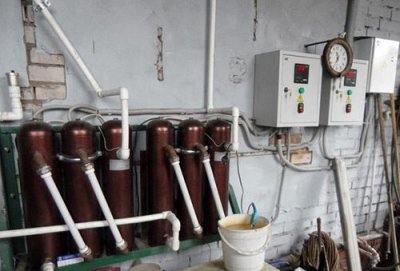
The induction heating option is most often considered in the case where when the gas main is not available And have to heat the home with expensive electricity.
An induction boiler is usually presented by sellers as a more economical and innovative alternative to conventional heating element heaters.
Content
What is induction heating
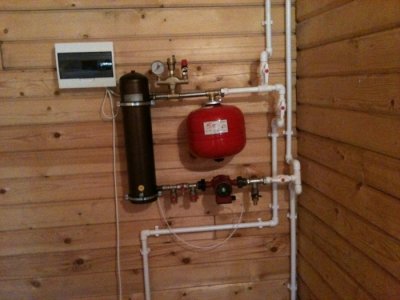
The work is based on phenomenon of electromagnetic induction. An electromagnetic field is created inside the boiler, which heats the ferromagnetic core. It gives off heat to the water in the system instead of the usual heating element.
When sellers and manufacturers VINs (vortex induction heaters) When talking about its efficiency, they mean the speed of heating the element and the transfer of heat to the system.
If the heating element heats the water in the heating system in the best case, 20, and even 30-40 minutes, then the induction element 10-15 minutes faster.
Important! In induction heating, the choice of coolant is quite wide: it can be not only water, but also oil, ethylene glycol and any antifreeze.
Operating principle and device of an induction electric boiler
Similar to a transformer. The induction current generator consists of primary and secondary short-circuited windings. The primary winding converts electrical energy into eddy current, and the secondary winding serves as the inductor body.
The following example will explain the operation of the induction heating device even more simply:
- A coil is wound onto a pipe made of a dielectric material (non-conductive to electric current).
- A core made of martensitic or ferritic steel (ferromagnet) is placed inside.
- The coil, when exposed to electricity, creates a magnetic field.
- The magnetic field heats the core (up to 750 °C).
- The core heats the water passing through the pipe.
Reference. Despite the fact that an induction boiler can quickly heat a large amount of coolant, and the phenomenon of induction itself creates convection movement of the carrier in the system, in order to heat a two-story house without problems, A pump needs to be installed in the system.
Most often, an induction boiler is quite compact, not too tall (40 cm), but weighty (up to 23-30 kg) a wide cylinder-pipe. Therefore, to prevent it from collapsing, it is placed on strong additional fastenings. Sometimes, to enhance the effect, a soldered section of several such cylinder-shaped boiler pipes is used.
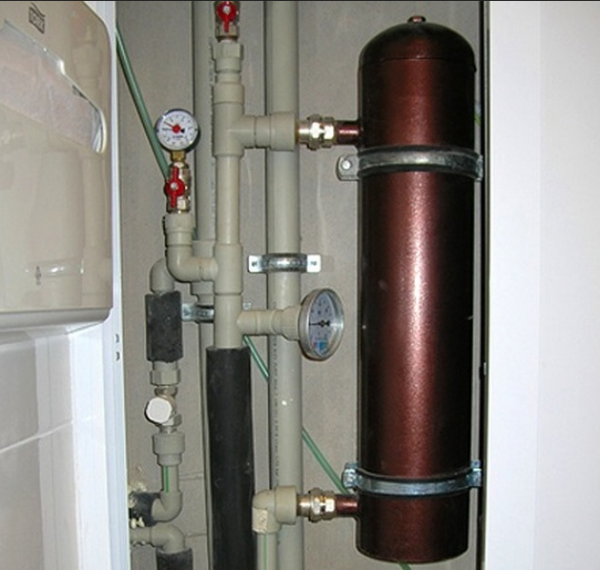
Photo 1. Induction boiler connected to the heating circuit. It is a small cylinder.
Less common are structures in the form locker.
But in any case, the induction boiler consists of:
- Corps, consisting of a dielectric metal.
- Electrical insulating layer.
- Heart from a ferromagnet (thickness up to 7 mm).
- Temperature sensor in the boiler body.
- Inlet and outlet pipes connections to the pipe and radiator system.
- Automatic switches (in the control panel).
- Thermostat (electronics in the control panel).
And this is what a heating system might look like, where:
- Pump for circulation of the coolant.
- Heating batteries.
- Induction boiler.
- Membrane expansion tank (to regulate pressure).
- Control panel cabinet.
- Shut-off ball valve.
Attention! An induction boiler is only suitable for closed heating circuit.
A little about the induction cooker
This miracle stove is different from ordinary slabs in that:
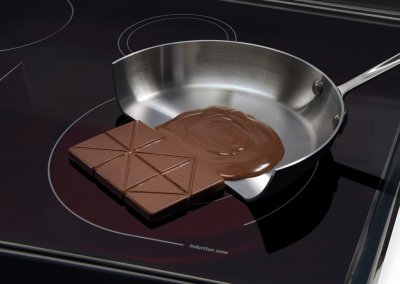
- Automatically recognizes suitable dishes (only made of ferromagnetic metals and with a flat bottom), and under the wrong one it doesn’t even turn on.
- Heats up faster, than gas or electric, therefore, dishes are prepared more quickly.
- Heats a strictly defined area, equal to the diameter of the cookware. The rest of the stove remains cold.
The layout of such a stove may differ significantly in different brands, but its the basic design is the same for all models:
- Glass ceramic surface.
- There is an insulating layer underneath.
- Under the insulation is an induction coil.
- Under the coil is the Control Unit and Frequency Converter.
Primary circuit in such a transformer, the coil is inside the plate, and secondary the outline is the dish itself.
On the Internet you can even find funny schemes of homemade heating systems using induction cookers. But They don't stand up to any criticism.
Induction cookers operate at ultra-high frequencies. from 20 kHz to 60 kHz. By measuring the radiation, it was found that some of it is absorbed by the plate itself, while the rest acts strictly within a radius of 30 cm from the center of the plate. However, despite the proven safety, people with pacemakers are strongly advised not to use such stoves, in order to avoid cardiac arrest. And what about the harmful radiation of an induction boiler? After all, it also operates at frequencies from 25 kHz and above.
Pros and cons of an induction electric boiler
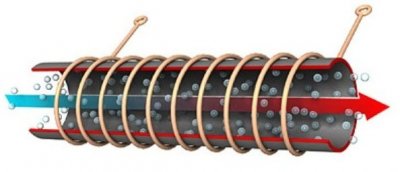
Cons induction boiler:
- While it is true that such a boiler is environmentally friendly and does not emit exhaust gases into the environment, it does spread an electromagnetic field throughout the home. People, animals and technology react to it.
- Only conditionally safe. If there is a coolant leak, the electromagnetic field will not be switched off automatically, the core will continue to heat up until the case melts, and this will happen literally in a couple of seconds. Therefore, complex and reliable automatic control, which switches off the power supply in case of leaks, is very important for such a boiler. It is expensive. And in domestic models of induction heaters, for the sake of economy, cheap Chinese models are most often installed.
- It costs almost twice as much as a heating element. At the same time, its declared efficiency is clearly overstated and will take a long time to pay for itself.
- In rationality and economy seriously inferior to gas and solid fuel heating systems.
Advantages:
- Some models have a remote control option using an electronic programmer. via GSM channel. It can be really convenient to set the temperature by 8-10 °C during the absence of people in the house, leaving for a week, without worrying about the freezing of the home.
- No intermediate technical inspections, replacement of heating elements and others repair and maintenance work.
Who invented the induction heating unit?
The marketing argument about the innovation of the induction boiler does not stand up to any criticism. The principle of induction was discovered in the first third of the 19th century by Michael Faraday — a researcher known to us from our school physics course.
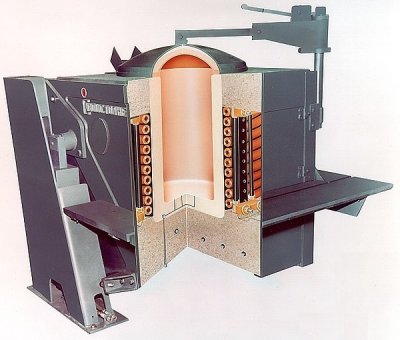
A at the very beginning of the 20th century in Sweden the first smelter was released into the world induction furnace for the metallurgical industry.
Of course, engineers and scientists were already considering induction for domestic heating boilers. But, having studied the pros and cons, they considered this option irrational.
Induction heaters for home and everyday life have started to be used in the CIS in the mid-90sBefore this, high-power induction boilers were used in the USSR only in heavy industry for smelting metals.
Is it true that induction heaters are energy efficient?
Economy This type of boiler achieves only initial head start of 5-15 minutes of heating speed. And that, in comparison with heating elements. Because the most economical among electric heating systems is "warm floor". All reasoning O 99 or even 100% efficiency is deceit and the calculation is based on mass illiteracy. All electric heaters have the same efficiency.
And the statement that part of the heat from the system is dissipated before reaching the coolant is equally true for both heating element and induction boilers. Considering the high cost of the boiler and the mandatory additional equipment for the induction system for a separate fee, Saving 30-50% on electricity is nothing more than a legend and a sales gimmick.
Durability. Like everything else in the world, the core is also subject to destruction, but it will do so, unlike the heating element, much longer - 30 years old. The other components also have a good margin of safety. Manufacturers provide a 10-year warranty on the service of the induction boiler, and they are not lying. If you equip it high-quality European electronic controllers, will serve freely and up to 30-40 years.

Photo 2. Induction boiler connected to a closed heating system. Additionally equipped with a controller, expansion tank and pump.
Considering the above, the owner of an induction boiler will notice savings compared to a heating element boiler only in the long term - after five years of use system. But compared to the initial installation costs, it may be insignificant.
Installation diagram of a device for heating water in a heating system
The first thing you should pay attention to is the correct calculation of power. It is better, of course, to invite a specialist, but if you do it yourself, use the formula: 60 W of boiler power per square meter of housing.
Here a number of standard rules that are mandatory during installation induction heating:
- Distance from the boiler to the wall exceeds 30 cm.
- Distance from the boiler to the ceiling and floor at least 80 cm.
- The outlet pipe must be immediately fitted with pressure gauge, air bleeder and relief valveThis is an absolute safety condition.
- Following the safety group, it is advisable to connect the hot feed to the return, i.e. close the small loopThis is a safety measure against overheating.
- After security groups mount shut-off valves.
- Boiler must be attached to the wall vertically using special fasteners or clamps.
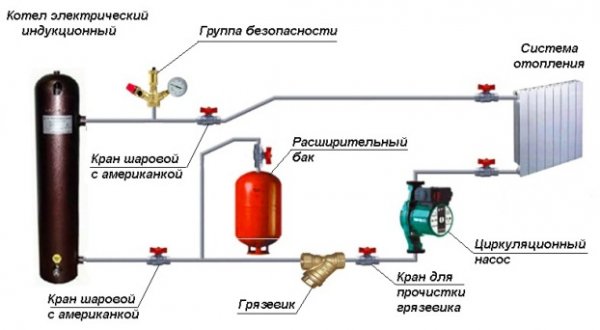
Photo 3. Induction boiler connection diagram to the heating system. The arrows show the parts of the structure.
Auxiliary devices are attached to the return flow pipe in the following sequence:
- Expansion tank.
- Sedimentation filter.
- Coarse filter.
- Pump.
- Circulation sensor.
Important! For induction heater Be sure to ground! It is best to use a separate wire for this (preferably a busbar) and connect it to the ground of the entire house.
Useful video
Watch the video to find out if induction boilers are really energy efficient?
Conclusion
There are no obvious advantages of induction heating over other types of heating systems, given its high price.
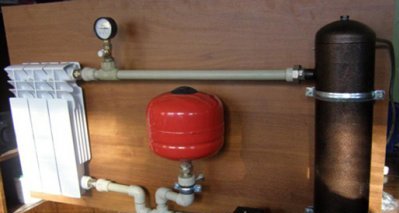
But if you draw a portrait of his ideal consumer, it would be owner of a country estate located in a non-gasified area, who requires a remotely controlled heating system for infrequent and moderate use.
And it is possible to install an induction boiler in the basement so that it does not emit harmful fields towards the residents, but, on the contrary, scares away mice, moles and rats. Durability and lack of periodic maintenance will really be a plus for such a consumer it will justify all costs in the long term.







